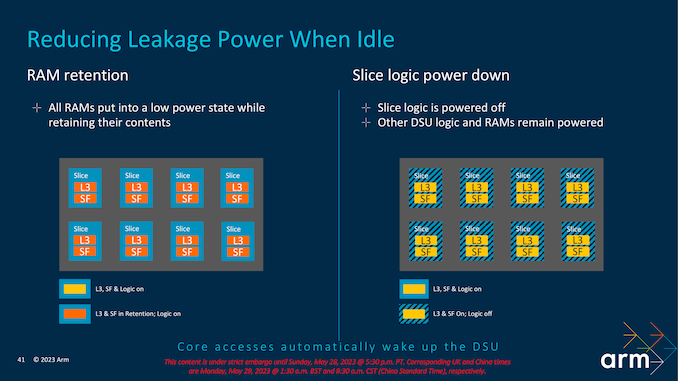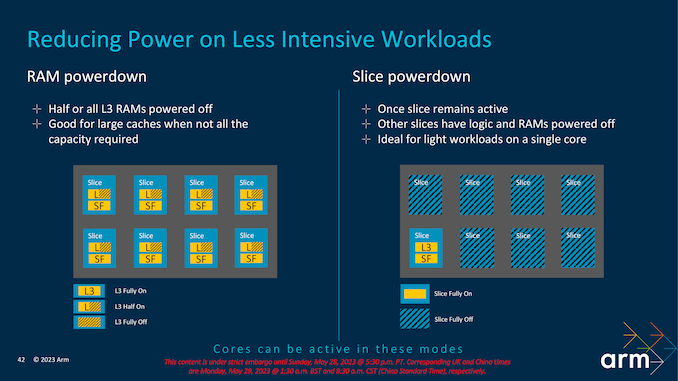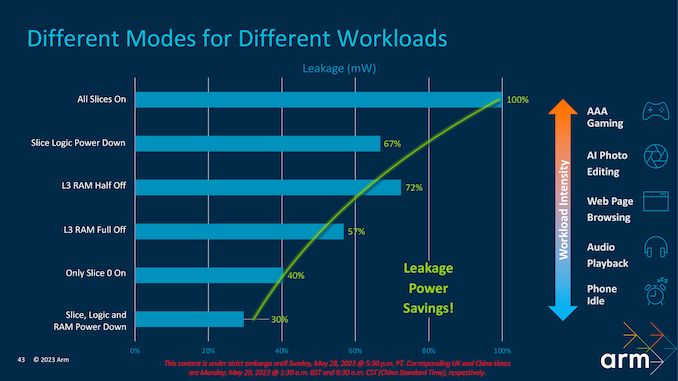Arm Unveils 2023 Mobile CPU Core Designs: Cortex-X4, A720, and A520 - the Armv9.2 Family
by Gavin Bonshor on May 28, 2023 8:30 PM ESTNew DSU-120: More L3 Cache, Doubling Down on Efficiency
For the launch of its Armv9.2 architecture, Arm has decided to opt for a new core complex design for its TCS23 CPU cores by building upon the foundations of its current DSU-110 block. Initially introduced in 2017 along with the Cortex A75 and A55 cores, DSU-110 represented a significant redesign and generational shift to integrate larger pools of shared L3 cache, bandwidth, and scalability. Along with the efficiency tweaking Arm has done to its new Cortex-X4, Cortex-A720, and A520 cores, the new DynamIQ Shared Unit-120 (DSU-120) also plays a significant role in these advancements.
Building a more refined DSU instead of another ground-up design, Arm has made plenty of inroads to improving overall scalability, efficiency, and performance with its DSU-120. Some of the most notable improvements include support for up to 14 CPU cores in a single cluster, which allows SoC vendors to pick and choose their core cluster configurations to suit the device going to market. Arm has also improved its Power and Performance Area (PPA) by implementing new power-saving modes, including RAM and Slicing power-downs, which work in stages depending on the type of workload and the intensity to reduce the overall power footprint of the cluster.
Perhaps the most significant change to DSU-120 from DSU-110 is that Arm has effectively doubled the total amount of shared L3 cache a cluster can implement. DSU-110 initially supported up to 16 MB, whereas DS-120 can now accommodate up to 32 MB of shared L3 cache across the entire complex, with other options also available, including 24 MB. While this isn't a direct implementation into the IP, the decision on the number of L3 cache implemented is entirely down to SoC vendors to decide the right levels of L3 cache based on performance and efficiency balancing depending on the device. The key focus is that DSU-120 and the new TCS23 cluster have the ability to support this if vendors wish to implement more L3 cache.
As with the current/previous DSU-110 interconnect, the new DSU-120 also uses a dual bi-directional ring-based topology, which allows data transmission in both directions within the cluster and reduces overall latency. The overall design of the DynamIQ Shared Unit is to optimize things for latency and increase bandwidth, which is precisely what Arm has done by slicing its logic L3 and snoop filters. As such, it is configurable based on specific customer bandwidth requirements. As previously mentioned, DSU-120 allows up to 14 Cortex-X/A cores to be implemented into a cluster, with plenty of benefits of opting for the latest Armv9.2 generation over the previous iterations.
Focusing on the new power improvements to the TCS23 and DSU-120 complex, Arm has identified specific areas where it can save on power to maximize efficiency. One of these is through RAM and reducing any unnecessary power leakage associated with that. To combat this, Arm has opted for a mechanism that allows RAM to be placed into a low-powered state when not being actively used, but still with enough power to ensure the integrity of its contents. The Logic is split into slices with the L3 cache and a snoop filter designed to improve cache coherence within a multi-core complex.
Opting for a sliced approach with snoop filters enables a couple of things. Firstly as we've mentioned, it improves and enhances cache coherence. This means that the cores are fed consistently and up-to-date instructions, and the snoop filter itself is designed to filter out requests that are deemed unnecessary, which does give some efficiency benefits. Secondly, slicing allows Arm's IP to increase scalability, which with an increase in cores, means an increase in slices with dedicated cache slices, allowing for better distribution of data and lower data contention rates. Armv9.2 IP with the DSU-120 allows for between 1 and 8 slices to be used, designed to enable SoC vendors the flexibility to work within their bandwidth requirements.
Arm claims that RAM power-down enabled across half of the L3 RAMs on the complex is suitable for large L3 caches when all of the capacity isn't being used. By allowing RAM power-down, all of the unused RAM is put into a low power state, but with enough to keep the contents and withhold their integrity within the memory substructure. Even with RAM and Slice power-downs active, the cores can still be active and process relevant instructions and data. One slice will effectively remain active, which is ideal for smaller and light workloads on a single core, but when it comes to powering down features on the DSU-120 interconnect, accessing the cores will enact a wake-up of the DSU-120.
Looking at how this efficiency translates into data, Arm has provided a handy slide with estimates from its own testing. As we can see, with various levels of RAM and Slice Logic power-downs, we get varied potential power savings, which can then be budgeted back into the cores themselves for higher performance levels. Different workloads and tasks require different levels of core power, coherence, intensity, and L3 allocation, so different power-downs lead to varying levels of leakage and power efficiency savings. Arm's figures estimate between 30 and 72% at the other states of power-down, with 100% savings in leakage with all the slices enabled.
















52 Comments
View All Comments
tipoo - Sunday, May 28, 2023 - link
6 years after iOS went 64 bit only. I'm guessing the cores have also been 64 bit only there for a while?goatfajitas - Monday, May 29, 2023 - link
IOS is an OS from one company that is made for a few specific products from that one company. You cant evenly compare an open platform to a narrow closed market like that.iAPX - Monday, May 29, 2023 - link
Yes Apple SoC seems to be 64bit-only for years, that simplify their own design and gives more efficiency.As 64bit ARM ISA as nothing in common with 32bit ARM ISA, contrary to the x86 and AMD64, they basically started with a blank page, profiting from experience of various preceding 64bit ISA, I feel it was the right way to go.
dotjaz - Monday, May 29, 2023 - link
No it's not, Apple is not allowed to modify ARM ISA. If it's ARMv8 compliant, it CANNOT possibly be 64bit only.Doug_S - Monday, May 29, 2023 - link
ARMv8 makes execution of AArch32 optional. Apple may have been responsible for that as they were involved in the spec of ARMv8 and AArch64 - they would have known they'd want to drop 32 bit code as soon as it was practical.dotjaz - Tuesday, May 30, 2023 - link
That's factually UNTRUE, Aarch32 execution is mandatory in **hardware implementation**, Aarch64 **OS** can choose not to execute Aarch32 codesDoug_S - Tuesday, May 30, 2023 - link
Sorry but you are wrong, ARMv8 specifically makes support for AArch32 optional for hardware implementations.Jaybird99 - Monday, May 29, 2023 - link
Apple is a founding partner with an architectural license. They can change anything they wish on the CPU design, then have it fabricated. I thought this was known because of the wildly different core design from Apple. They take the ISA they pick and choose and add/delete what they need. They actually help ARM in the long run as seeing how Apple uses 64bit and finds solutions to their issues, because as stated above 64bit was blank slate for ARM. I'm very fairly certain of this, but if you know something I don't? (I might not..)Doug_S - Monday, May 29, 2023 - link
An architectural license allows them to implement the ISA, but they can't delete things from it. They are able to add things to it (i.e. TSO, their AMX instructions, etc.) but it still has to pass ARM's conformance tests to show it is capable of running ARM code.They were able to "delete" AArch32 because ARMv8 allows that. ARMv9 goes further and makes AArch32 a special license addition or something like that - basically Aarch32 is deprecated with ARMv9 and will probably go away entirely with ARMv10.
dotjaz - Tuesday, May 30, 2023 - link
No, they were not able to "delete" AArch32. They can disallow AArch32 codes execution in their OS just like Google Pixel 7-series, they cannot remove the support from hardware.And Apple did not add anything to ARM ISA. AMX is masked as a co-processor only available through frameworks, it doesn't directly execute any code other than a "firmware".
TSO is not an instruction. It's a **mode**. It pertains to HOW the CPU reorders L/S queue. It has nothing to do with the ISA.